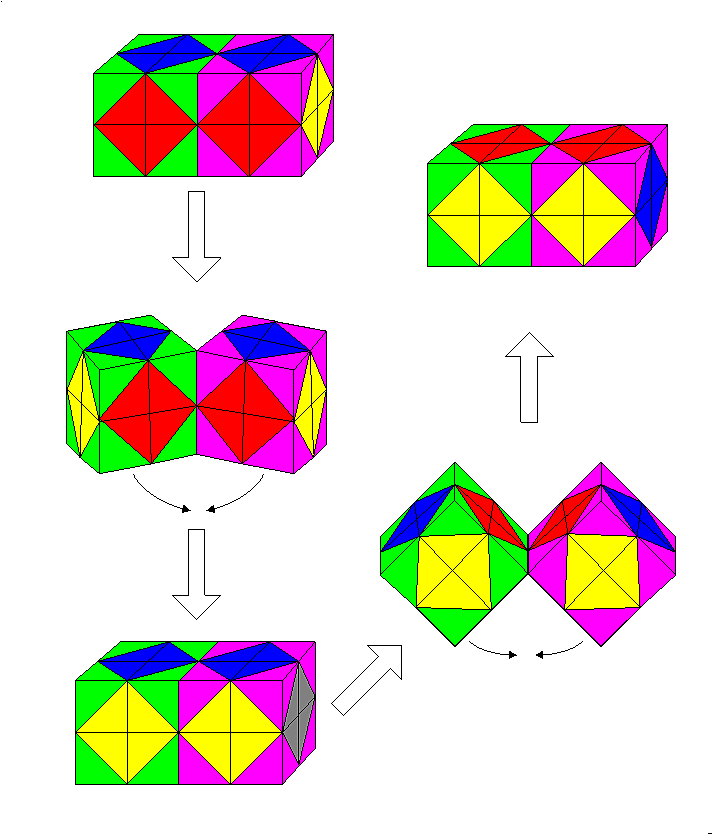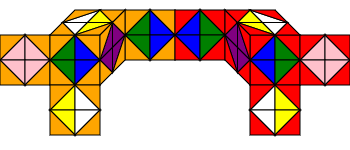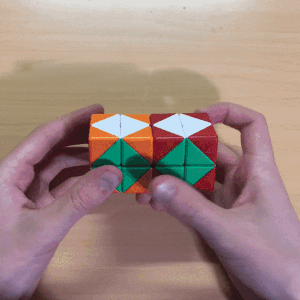Physical 2x2x2x2 Canonical Moves & Notation¶
Info
Watch Melinda Green’s video for a quick overview of the canonical moves
The Canonical Moveset is a set of moves agreed upon by the community for solving the physical 24. To get accepted into the official Hall of Fame, you must follow the canonical moves exactly. Make sure that you have already solved a virtual 24, and are familiar with how the pieces of the physical 24 correspond. Also make sure that you know your 3D rotations (x y z) very well.
Canonical Moves¶
Simple Rotations¶
A lot of the whole puzzle reorientations can be reached without the need for the gyro algorithm. These are called simple rotations, and consist of rotaing the L and R cells together in opposing directions (as to not change the state of the puzzle, only its orientation).
zy yz yw wy zw wz
Cell Twists¶
The left and right cells of the puzzle can be twisted into any reorientation of a cube. In other words, there are 23 different twists of the L/R cells:
Left cell twists: Ly Ly' Ly2 Lx2 Lz2 Lx2,y Lx2,y' Lx Lx,y Lx,y' Lx,y2 Lx' Lx',y Lx',y' Lx',y2 Lz Lz,y Lz,y' Lz,y2 Lz' Lz',y Lz',y' Lz',y2
Right cell twists: Ry Ry' Ry2 Rx2 Rz2 Rx2,y Rx2,y' Rx Rx,y Rx,y' Rx,y2 Rx' Rx',y Rx',y' Rx',y2 Rz Rz,y Rz,y' Rz,y2 Rz' Rz',y Rz',y' Rz',y2
Each move here either starts with an L or an R, followed by the rotations (separated by commas).
Inside/Outside Twists¶
The I and O cells are the sides with the next most turning freedom after L and R. This was referred to as an “axial twist” in Melinda’s video. The canonical moves for the I/IO cells are Ix Ix' Ix2 Ox Ox' Ox2
These twists can be difficult to perform for speedsolving, so most people tend to split it up by temporarily doing 2 illegal 90 degree twists that yield the same result. Be careful though, as this can lead to an illegal state if you accidentally screw up while doing it this way.
Slab Twists¶
The remaining canonical twists involve picking up a 2x2x4 “slab” off the puzzle, and rotating it 180 degrees in the same plane. These slabs you can pick up are the U, F, D, and B cells. Because the slabs can only be turned 180 degrees those moves will just be referred to as U2 F2 D2 B2
Gyro¶
If you try to scramble the puzzle with the moves above, you will quickly notice that the two colours on the x-axis aren’t mixing with the other colours. This is because the reduced symmetry of the physical puzzle, relative to the virtual puzzle, restricts what we can do. As a result, we use a sequence of non-canonical moves that rotate the puzzle four-dimensionally in a way that changes the x-axis. This sequence of moves is called the Gyro, and will allow us to access all the rest of the puzzle rotations: xz, zx, yx, xy, xw, and wx.
There are several different Gyro algorithms, some of which cycle different axes. Melinda has several videos about different gyro algorithms, the shortest known one being 6 snaps. Below is a common gyro algorithm that several people in the community use.
- Take the left endcap off and put it on the right so it becomes the right endcap (this brings the puzzle into the inverted state)
LyRy'- Take the right endcap off and put it on the left so it becomes the left endcap (this brings the puzzle back into the normal state)
Rx2B2D2Lx2
Expanded Canonical Moveset¶
The expanded canonical moveset is what is accepted for the Hypercubing.xyz leaderboards. These moves all correspond perfectly with twists on the virtual puzzle, but weren’t allowed in the canonical moveset because people agreed not to for some reason.
Extra slab twists¶
Several new slab twists are added. For the U cell, this means going from having just Uy2 to now having Uy2 Ux,y2 Ux',y2 Ux Ux' Ux2 Uz2
Extra I/O cell twists¶
Iz2 Iy2 Oz2 Oy2 are added (although they are very hard to fingertrick and perform quickly).
Scramble notation¶
Scrambles use comma-separated cell twists and the special move #. # represents a Uy2 move followed by a “left-to-right restack,” which consists of taking the left endcap off and putting it on the right side of the puzzle. This is not a legal move during solves, but does result in a legal puzzle state so it is used during scrambles.



